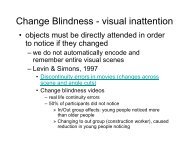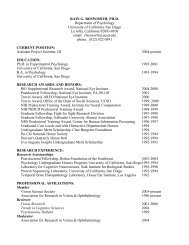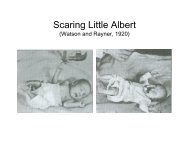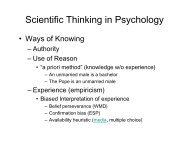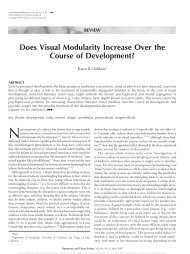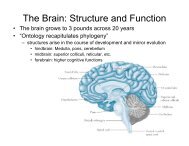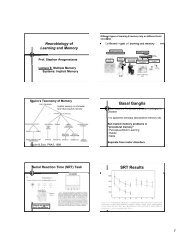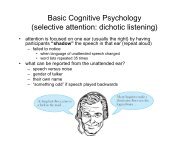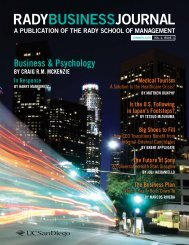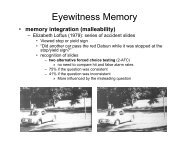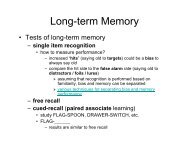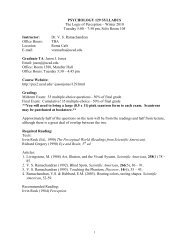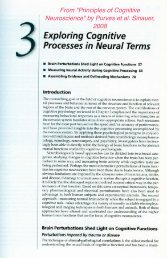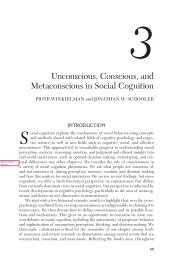Confirmation Bias: A Ubiquitous Phenomenon in Many Guises
Confirmation Bias: A Ubiquitous Phenomenon in Many Guises
Confirmation Bias: A Ubiquitous Phenomenon in Many Guises
You also want an ePaper? Increase the reach of your titles
YUMPU automatically turns print PDFs into web optimized ePapers that Google loves.
212 RAYMOND S. NICKERSON<br />
Arkes, H. R., Faust, D., Guilmette, T. J., & Hart, K.<br />
(1988). Elim<strong>in</strong>ation of the h<strong>in</strong>dsight bias. Journal<br />
of Applied Psychology, 73, 305-307.<br />
Bacon, F. (1939). Novum organum. In Burtt, E. A.<br />
(Ed.), The English philosophers from Bacon to Mill<br />
(pp. 24-123). New York: Random House. (Orig<strong>in</strong>al<br />
work published <strong>in</strong> 1620)<br />
Baddeley, A. D., & Woodhead, M. (1983). Improv<strong>in</strong>g<br />
face recognition ability. In S. M. A. Lloyd-Bostock<br />
& B. R. Clifford (Eds.), Evaluat<strong>in</strong>g witness<br />
evidence. Chichester, England: Wiley.<br />
Barber, B. (1961). Resistence by scientists to<br />
scientific discovery. Science, 134, 596-602.<br />
Baron, J. (1985). Rationality and <strong>in</strong>telligence. New<br />
York: Cambridge University Press.<br />
Baron, J. (1991). Beliefs about th<strong>in</strong>k<strong>in</strong>g. In J. F. Voss,<br />
D. N. Perk<strong>in</strong>s, & J. W. Segal (Eds.), Informal<br />
reason<strong>in</strong>g and education (pp. 169-186). Hillsdale,<br />
NJ: Erlbaum.<br />
Baron, J. (1994). Th<strong>in</strong>k<strong>in</strong>g and decid<strong>in</strong>g (2nd ed.).<br />
New York: Cambridge University Press.<br />
Baron, J. (1995). Myside bias <strong>in</strong> th<strong>in</strong>k<strong>in</strong>g about<br />
abortion. Th<strong>in</strong>k<strong>in</strong>g and reason<strong>in</strong>g, 7, 221-235.<br />
Baron, J., Beattie, J., & Hershey, J. C. (1988).<br />
Heuristics and biases <strong>in</strong> diagnostic reason<strong>in</strong>g II:<br />
Congruence, <strong>in</strong>formation, and certa<strong>in</strong>ty. Organizational<br />
Behavior and Human Decision Processes,<br />
42, 88-110.<br />
Barrows, H. S., Feightner, J. W., Neufeld, V. R., &<br />
Norman, G. R. (1978). Analysis of the cl<strong>in</strong>ical<br />
methods of medical students and physicians.<br />
Hamilton, Ontario, Canada: McMaster University<br />
School of Medic<strong>in</strong>e.<br />
Barrows, H. S., Norman, G. R., Neufeld, V. R., &<br />
Feightner, J. W. (1977). Studies of the cl<strong>in</strong>ical<br />
reason<strong>in</strong>g process of medical students and physicians.<br />
Proceed<strong>in</strong>gs of the sixteenth annual conference<br />
on research <strong>in</strong> medical education. Wash<strong>in</strong>gton,<br />
DC: Association of American Medical Colleges.<br />
Bassock, M., & Trope, Y. (1984). People's strategies<br />
for test<strong>in</strong>g hypotheses about another's personality:<br />
Confirmatory or diagnostic? Social Cognition, 2,<br />
199-216.<br />
Beattie, J., & Baron, J. (1988). <strong>Confirmation</strong> and<br />
match<strong>in</strong>g biases <strong>in</strong> hypothesis test<strong>in</strong>g. Quarterly<br />
Journal of Experimental Psychology, 40A, 269-<br />
298.<br />
Beck, A. T. (1976). Cognitive therapy and the<br />
emotional disorders. New York: International<br />
Universities Press.<br />
Bell, E. T. (1991). The magic of numbers. New York:<br />
Dover. (Orig<strong>in</strong>al work published 1946)<br />
Berwick, D. M., F<strong>in</strong>eberg, H. V., & We<strong>in</strong>ste<strong>in</strong>, M. C.<br />
(1981). When doctors meet numbers. American<br />
Journal of Medic<strong>in</strong>e, 71, 991.<br />
Beyth-Marom, R., & Fischhoff, B. (1983). Diagnosticity<br />
and pseudodiagnosticity. Journal of Personality<br />
and Social Research, 45, 1185-1197.<br />
Blackstone, W. (1962). Commentaries on the laws of<br />
England of public wrongs. Boston: Beacon.<br />
(Orig<strong>in</strong>al work published 1769)<br />
Boorst<strong>in</strong>, D. J. (1958). The Americans: The colonial<br />
experience. New York: V<strong>in</strong>tage Books.<br />
Boorst<strong>in</strong>, D. J. (1985). The discoverers: A history of<br />
man's search to know his world and himself. New<br />
York: V<strong>in</strong>tage Books.<br />
Bruner, J. S., Goodnow, J. J., & Aust<strong>in</strong>, G. A. (1956).<br />
A study of th<strong>in</strong>k<strong>in</strong>g. New York: Wiley.<br />
Bruner, J. S., & Potter, M. C. (1964). Interference <strong>in</strong><br />
visual recognition. Science, 144, 424—425.<br />
Camerer, C. (1988). Illusory correlations <strong>in</strong> perceptions<br />
and predictions of organizational traits.<br />
Journal of Behavioral Decision Mak<strong>in</strong>g, 1, 11-94.<br />
Campbell, J. D., & Fairey, P. J. (1985). Effects of<br />
self-esteem, hypothetical explanations, and verbalization<br />
of expectancies on future performance.<br />
Journal of Personality and Social Psychology, 48,<br />
1097-1111.<br />
Cassells, W., Schoenberger, A., & Grayboys, T. B.<br />
(1978). Interpretation by physicians of cl<strong>in</strong>ical<br />
laboratory results. New England Journal of Medic<strong>in</strong>e,<br />
299, 999.<br />
Chapman, L. J. (1967). Illusory correlation <strong>in</strong><br />
observational report. Journal of Verbal Learn<strong>in</strong>g<br />
and Verbal Behavior, 6, 151-155.<br />
Chapman, L. J., & Chapman, J. P. (1959). Atmosphere<br />
effect reexam<strong>in</strong>ed. Journal of Experimental<br />
Psychology, 58, 220-226.<br />
Chapman, L. J., & Chapman, J. P. (1967a). Genesis of<br />
popular but erroneous psychodiagnostic observations.<br />
Journal of Abnormal Psychology, 72, 193-<br />
204.<br />
Chapman, L. J., & Chapman, J. P. (1967b). Illusory<br />
correlation as an obstacle to the use of valid<br />
psychodiagnostic signs. Journal of Abnormal<br />
Psychology, 74, 271-280.<br />
Chapman, L. J. & Chapman, J. P. (1969). Illusory<br />
correlation as an obstacle to the use of valid<br />
psychodiagnostic signs. Journal of Abnormal<br />
Psychology, 74, 271-280.<br />
Cheng, P. W., & Holyoak, K. J. (1985). Pragmatic<br />
reason<strong>in</strong>g schemas. Cognitive Psychology, 17,<br />
391-416.<br />
Chernev, A. (1997). The effect of common features on<br />
brand choice: Moderat<strong>in</strong>g the effect of attribute<br />
importance. Journal of Consumer Research, 23,<br />
304-311.<br />
Cherniak, C. (1986). M<strong>in</strong>imal rationality. Cambridge,<br />
MA: MIT Press.<br />
Christensen-Szalanski, J. J., & Bushyhead, J. B.<br />
(1988). Physicians' use of probabilistic <strong>in</strong>formation<br />
<strong>in</strong> a real cl<strong>in</strong>ical sett<strong>in</strong>g. In J. Dowie & A. Elste<strong>in</strong><br />
(Eds.), Professional judgment. A reader <strong>in</strong> cl<strong>in</strong>ical<br />
decision mak<strong>in</strong>g (pp. 360-373). Cambridge, England:<br />
Cambridge University Press. (Orig<strong>in</strong>al work<br />
published 1981)<br />
Clark, H. H. (1974). Semantics and comprehension.<br />
In T. A. Sebeok (Ed.), Current trends <strong>in</strong> l<strong>in</strong>guistics.



